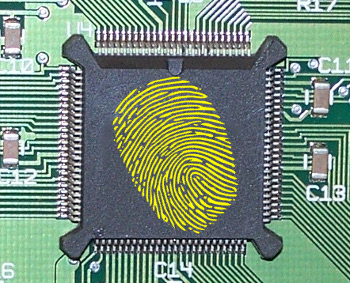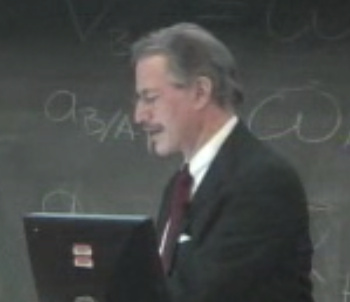Fingerprints
December 4, 2017
As a
child, I was a member of the
Boy Scouts of America for about two years. This was long before the many current
controversies associated with that organization, and my membership was understandable given the
rural nature of my home environment in Upstate New York. Our idea of a family vacation wasn't
Disneyland, which was too far away (
Walt Disney World didn't open until 1971) and too expensive for a
middle class family. Instead, we would camp at one of several
New York State Parks.
Scouts could earn "
merit badges" by demonstrating
skills in selected subject areas. There was
electricity, which was an easy topic for me, and there was also
fingerprinting. I was able to visit the local
police station to see how it was done, and I had my own fingerprints taken, the card on which they were imprinted now long since lost. Later, I needed to have my fingerprints taken in earnest when I got a
government security clearance, long since lapsed.

To paraphrase General Douglas MacArthur, who famously said that "...old soldiers never die; they just fade away," old boy scouts never die, they just end up looking like this.
I spent two weeks during one summer at a Boy Scout camp, where we started campfires by striking flint with steel, and planted some fir seedlings.
(Modified Wikimedia Commons image
The common conception of fingerprints is that they uniquely identify a person, and many
television shows perpetuate this idea. During the
Elliot Ness era,
career criminals supposedly defaced their fingerprints with
acid so they couldn't be traced to their
crimes. There's also the
saying when identifying an action that a person's "fingerprints are all over it." Some
computer devices will even
image a person's fingerprint as a
password to unlock a device, the idea being that only that person's fingerprint is valid.
Computer techniques have advanced fingerprint matching to a high degree, greatly enhancing the probability that there will be a "match" found to some person. The US
Federal Bureau of Investigation has developed an
Integrated Automated Fingerprint Identification System that's been highlighted on various
television crime shows; notably,
NCIS. The IAFIS contains fingerprints for more than a hundred million subjects, mine being mixed in there, somewhere. This system is routinely searched by various
law enforcement agencies in attempts to match
latent (crime scene) fingerprints to individuals.

Fingerprints in electronics meant an entirely different thing a decade ago than it does today.
(Fingerprint image via Wikimedia Commons. Circuit image by the author.)
Is there a
scientific basis to qualify fingerprinting, as practiced, as an unerring method of identification? Quite a few other "
forensic science" techniques have received criticism as not being as precise as claimed. As one example,
polygraph (lie detector) testing has been called a
pseudoscience.[1] What's especially interesting is the
US government's admission that a polygraph test can easily be defeated in its prosecution of coaching services that provided information on techniques to do this.[2] A polygraph in no way passes the same performance standards that I demand of my
analytical instruments.
While the scientific case for polygraph testing is weak, the emerging methods of
forensic DNA profiling, first introduced as a law enforcement technique in the early
1980s, are on firmer scientific ground.[3] DNA profiling can be a valid forensic tool, provided, however, that collection techniques are adequate, and the methods for
statistical analysis of the DNA data are justified. Several prominent criminal cases have illustrated insufficient technical
protocols, faulty interpretation of DNA evidence, or the reliance on
closed source software for analysis.[3]
The emerging
scientific consensus on fingerprint identification, the results of which are considered absolutely certain in the U.S.
judicial system, is that such trust is not warranted.[4] A presentation at this year's
69th Annual Scientific Meeting of the American Academy of Forensic Sciences, February 13-18 in
New Orleans, claimed that fingerprint analysis should be considered as
circumstantial evidence, only.[4]
Author of the presentation, "Fingerprint Science,"
Carnegie Mellon University emeritus professor of
statistics,
Joseph B. Kadane, says
"Fingerprints can be useful for eliminating suspects or linking crimes together, but as an identification tool, they are not as infallible as TV shows and judges and jurors are made to believe... Fingerprint analysts are exaggerating what they can do, and policies need to be changed to prevent this from happening. Courts need to stop accepting fingerprint identifications - because they have no scientific basis."[4]

Joseph B. Kadane at the 2006 Morris H. DeGroot Memorial Lecture.
(Still image from a Carnegie Mellon University video.
Fingerprint analysis was the topic of a huge, 160 page
report, "Forensic Science Assessments: A Quality and Gap Analysis - Latent Fingerprint Examination," prepared by the
American Association for the Advancement of Science.[5-7] This report states that courtroom testimony that fingerprints collected from a crime scene belong to a single person is indefensible and lacks scientific foundation.[7] Says Kaldane, who was also an
author of this report,
"Our review of the scientific literature found that there is no scientific way to estimate the number of people in some community - a city, a state, the country, the world - who share the characteristics found, and hence no scientific basis for identification."[7]
The
public holds misconceptions about latent fingerprint examination, and this is sometimes called "The CSI Effect," after the
popular television crime series.[7] The
scenes for that series were likely shaped by the many years of overstatement by latent print examiners. The report urges latent fingerprint examiners to include specific
caveats in their reports, including an acknowledgement that their conclusions are
opinions rather than
facts.[5]
Fingerprint analysis does have some science behind it. First, although there has not been a scientific assessment of the rarity of any
particular feature, or set of features, in a fingerprint, the
ridge patterns on human
fingers vary greatly among individuals.[5] Furthermore, fingerprints change very little over the life of an individual; and, when the prints from all ten fingers are considered, a specific individual can be identified to high
likelihood.[5-6]
Extrapolating from this basis, latent fingerprint examiners have made the overblown claim of 100% identification. While latent prints can exclude the preponderance of individuals, there is no scientific basis to identify a single person.[5]
Another concern is
automated fingerprint identification
software, all of which is proprietary so the source code cannot be examined to determine its
assumptions and
accuracy.[5] Also, these systems can't match a latent crime scene fingerprint to another from a known source.[6] They can only identify similar features.[6] The report does state that "It is possible that automated fingerprint identification systems could
evolve over time."[6]
as every
scientist knows, the conclusion of every report is to recommend more
research. This report concludes that there are insufficient scientific
data on the potential pool of human fingerprints to determine how many people might display similar features.[6] The report further proposes research to determine whether latent fingerprint analysis is strong enough to be used as
evidence.[6] As stated in the report,
"Uncertainty in this area means there is an inadequate scientific foundation for determining how many features, or what types, are needed in order for an examiner to draw definitive conclusions about whether a latent print was made by a given individual and hence... examiners should not draw such conclusions."[6]
References:
- Gerhard Adam, "The Pseudoscience Of Lie Detectors," Science 2.0 Web Site, October 30, 2012.
- Joe Mullin, "Coach who taught people how to beat lie detectors headed to prison," Arstechnica, September 9, 2013.
- Lutz Roewer, "DNA fingerprinting in forensics: past, present, future," Investig Genet., vol. 4, no. 22 (November 18, 2013), doi:10.1186/2041-2223-4-22.
- Shilo Rea, "Fingerprint Evidence is Circumstantial, Not an Identification," Carnegie Mellon University Press Release, February 10, 2017.
- William Thompson, John Black, Anil Jain, and Joseph Kadane, "Forensic Science Assessments: A Quality and Gap Analysis- Latent Fingerprint Examination," American Association for the Advancement of Science, September 15, 2017, DOI: 10.1126/srhrl.aag2874 (6.4 MB PDF File).
- Anne Q. Hoy, "Fingerprint Source Identity Lacks Scientific Basis for Legal Certainty," AAAS News, September 15, 2017.
- Shilo Rea, "Fingerprints Lack Scientific Basis for Legal Certainty," Carnegie Mellon University Press Release, October 5, 2017.
Linked Keywords: Child; Boy Scouts of America; controversy; rural area; Disneyland; Walt Disney World; middle class; family; New York State Park; scout; merit badge; skill; electricity; fingerprint; fingerprinting; police station; government security clearance; paraphrase; General Douglas MacArthur; ...old soldiers never die; they just fade away; summer camp; campfire; flint; steel; fir; seedlings; Wikimedia Commons; television program; television show; Elliot Ness; habitual offender; career criminal; acid; crime; saying; computer device; image analysis; password; Federal Bureau of Investigation; Integrated Automated Fingerprint Identification System; police procedural; television crime show; NCIS (TV series); law enforcement agency; latent fingerprint; electronic; decade; science; scientific; forensic science; polygraph; pseudoscience; Federal government of the United States; analytical instrument; forensic DNA profiling; 1980s; statistics; statistical analysis; protocol; proprietary software; closed source software; scientific consensus; judiciary; judicial system; 69th Annual Scientific Meeting of the American Academy of Forensic Sciences; New Orleans; circumstantial evidence; Carnegie Mellon University; emeritus professor; Joseph B. Kadane; suspect; judge; jury; juror; court; Morris H. DeGroot Memorial Lecture; report; American Association for the Advancement of Science; author; scientific literature; community; city; state; country; world; public; CSI: Crime Scene Investigation; television crime series; scene; caveat; opinion; fact; fingerprint feature; ridge pattern; finger; likelihood; extrapolation; automation; automate; software; presupposition; assumption; accuracy; software evolution; scientist; research; data; evidence.